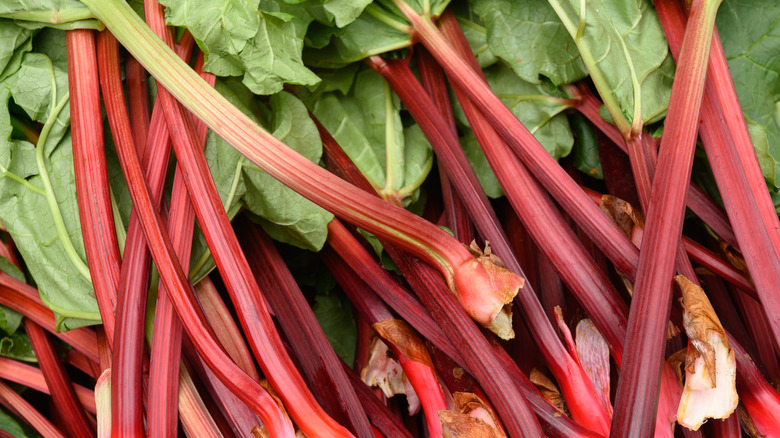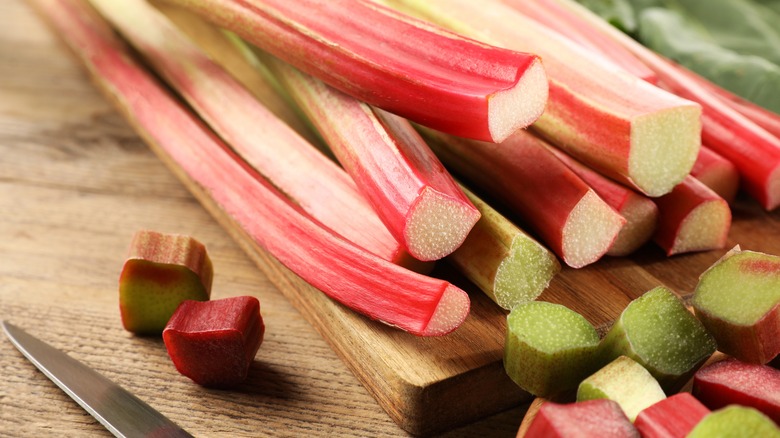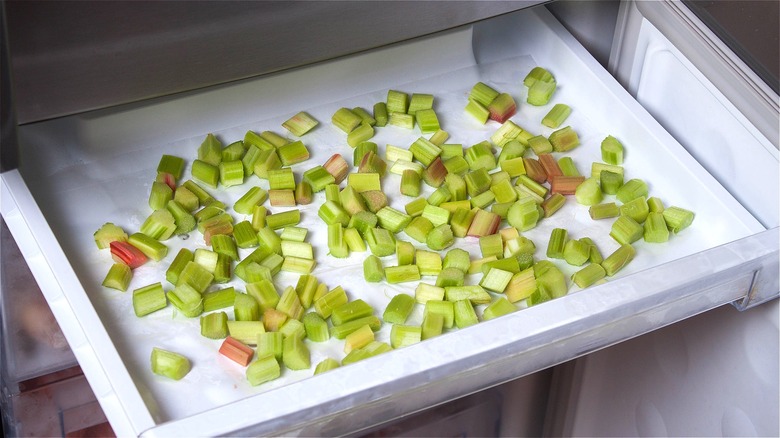How To Store Rhubarb So It Stays Crisp For Longer
There are certain fruits and vegetables that showcase a year's seasonal shifts. While pomegranates are more readily available in the fall and tangerines abound in winter, berries, asparagus, and rhubarb serve as signifiers of spring. If you're a fan of seasonal produce, securing bright red stalks of rhubarb at a grocery store near you is a telltale sign that summer is on its way. Yet, if you're hoping to prolong the shelf-life of this celery-like vegetable, you need to store rhubarb efficiently.
Rhubarb is a tart red vegetable available in supermarkets from March until June. Unlike celery, rhubarb stalks have a naturally sour taste and work well in both savory meals and fruit-based desserts. Keeping rhubarb firm and crisp is essential for extended use. Luckily, you don't have to do much legwork to maintain rhubarb's freshness at a base level.
To keep rhubarb crisp for up to 14 days, remove and discard the leaves and store the stalks, unwashed, in an open plastic bag in your refrigerator. Sealed bags prevent rhubarb's low levels of ethylene from escaping which can cause this seasonal veggie to ripen faster. Do not store rhubarb near high-ethylene-producing fruits like apples, peaches, and kiwi fruit. Consider utilizing your crisper drawer to keep rhubarb protected. Luckily, if you want to keep your rhubarb crisp and fresh-tasting past the two-week mark, there are a few creative storage methods worth trying.
Long lasting ways to keep rhubarb fresh
If you want to make more than one strawberry-rhubarb deep dish pie this month, rest easy with one of these clever storage methods. Instead of simply storing unwashed rhubarb in plastic, go an extra step and wrap rhubarb in aluminum foil. Unlike flimsy plastic bags, aluminum foil is sturdier and keeps rhubarb from drying out over a longer time period. Lay unwashed stalks on a long sheet of foil and wrap loosely. You want to maintain the perfect balance between wrapping your stalks well enough to prevent them from drying out and allowing the ethylene gas to escape the foil. Rhubarb stored in foil may last up to four weeks.
Surprisingly, there are a few more clever ways to store rhubarb that may also prolong this vegetable's shelf life. If you're committed to using plastic bags, before storing, wrap damp paper towels around your rhubarb stalks. This added layer of moisture will prevent your rhubarb from becoming limp and drying out fast. If you're looking to try a completely different method altogether, place your trimmed rhubarb stalks upright in a glass of water in your refrigerator. To further prevent moisture loss, cover the rhubarb tops with plastic wrap. Make sure to change the water every day for optimum results. Any one of these unique methods will keep your rhubarb crisp and fresh for a whole month. However, to keep this seasonal vegetable beyond four weeks, resort to your freezer.
How to easily enjoy rhubarb all year long
If you love rhubarb and hate how short this vibrant veggie seems to be in season, take advantage of your freezer. Peel the rhubarb if the outer skin looks extra fibrous, then wash and chop it into manageable pieces. To ward off oxygen exposure, try rolling rhubarb slices in sugar (just don't forget this added sugar when cooking with it later). It's recommended to first freeze your slices on a sheet pan before transferring your chunks to a more manageable container.
After your rhubarb freezes separately on a sheet pan, store it in an airtight container of your choice. Resealable freezer-safe storage bags work well, as does Tupperware. Whichever container you use, make sure your rhubarb is frozen in an airtight environment as exposure to air will compromise rhubarb's extended shelf life, so use a vacuum sealer if you have one.
While this tart vegetable may be stored effectively for up to a year in your freezer, your stores will begin to show signs of deterioration after a handful of months. Rhubarb can be defrosted in your refrigerator, but keep in mind that the freezing process may break down this veggie's firm structure (with this in mind, some people turn to blanching their veggies prior to freezing). Choose recipes where previously frozen rhubarb can be mixed in rather than neatly showcased. With the help of your freezer, you can make all your favorite rhubarb recipes that aren't just pie throughout the year.


